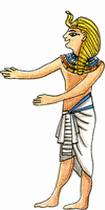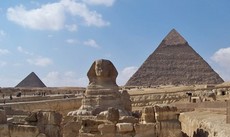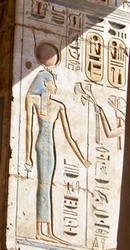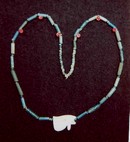Maps of the Antique
Mediterranean Sea
 The Egyptians The Egyptians
 Overview Overview
 Some dates Some dates
 Archaeological sites Archaeological sites
 Egyptian Art Egyptian Art
 World's museums World's museums
 Coinage Coinage
 Language and Writing Language and Writing

|
ANCIENT EGYPT
History, archaeology, art, collections or... "Egyptomania"?
It is unquestionable : since 1800 and Bonaparte’s campaign in Egypt, a real passion exists for eveything that relates to Egypt. Websites on this field are quite numerous. And this is not just a vogue: this fascination has been going on continuously for more than 200 years! Well, we’ll try nevertheless to bring our little stone to this huge pyramid, while avoiding to encroach for a hundredth time on the territory of those who already devote themselves to this field with more historical knowledge or photographic skill that we could ever have.
The Egyptian civilization: what makes it so extraordinary ?
 The mysteries of the old golden stones lost in the desert, these gods which look like created by the fantasy of an hallucinated cartoonist, this lively manner to deal with death, this passion for eternity, this writing which looks like a mysterious rebus, these intricate funerary rites, the beauty of a fascinating art and the profusion of gold, the serenity which the frescos in the tombs express sometimes, the adventure of hunting for inviolate tombs, the duration of this civilization that stretches over three millenia, its disproportiona, “Pharaonic” works: all that stimulates our imagination, and each aspect of ancient Egypt attracts and fascinates. More philosophy and humanism may be found in Greece, more serenity in Etruria, more power in Rome: nothing can help, the Egyptians stay in everyone’s imaginative world. The mysteries of the old golden stones lost in the desert, these gods which look like created by the fantasy of an hallucinated cartoonist, this lively manner to deal with death, this passion for eternity, this writing which looks like a mysterious rebus, these intricate funerary rites, the beauty of a fascinating art and the profusion of gold, the serenity which the frescos in the tombs express sometimes, the adventure of hunting for inviolate tombs, the duration of this civilization that stretches over three millenia, its disproportiona, “Pharaonic” works: all that stimulates our imagination, and each aspect of ancient Egypt attracts and fascinates. More philosophy and humanism may be found in Greece, more serenity in Etruria, more power in Rome: nothing can help, the Egyptians stay in everyone’s imaginative world.
Some nonconformist points of view
 Considering Egypt’s history as a long quiet river would be completely wrong. There were surely some times of dazzling prosperity (the Old, Middle and New Kingdom), but in the meantime - and sometimes even during these periods – how many quarrels, dissensions, wars and even periods of foreign occupation!
And if any simple passer-by knows that first came the pyramids, then a millenium later the first temples and tombs that he may visite today, he forgets easily that more than half of the monuments he’ll see were built or rebuilt by Greeks or Romans.
Considering Egypt’s history as a long quiet river would be completely wrong. There were surely some times of dazzling prosperity (the Old, Middle and New Kingdom), but in the meantime - and sometimes even during these periods – how many quarrels, dissensions, wars and even periods of foreign occupation!
And if any simple passer-by knows that first came the pyramids, then a millenium later the first temples and tombs that he may visite today, he forgets easily that more than half of the monuments he’ll see were built or rebuilt by Greeks or Romans.
Indeed, the artistic schemes evolved relatively few over 3000 years, the sacred writing (hieroglyphs) changed less than the French language within two centuries, and the royal symbols kept an extraordinary continuity. This is undoubtedly an evidence of the importance that the ancient Egyptian attached to the balance of all things (Maat) that no one should disturb - a trend that the royalty warmly encouraged !
We will approach the Egyptian History:

- through an interactive map of the archaeological sites, while highlighting the period they cover, and how they are related along with time. We’ll locate on it the events by specifying the dynasty ruling at the time.
- through a chronological table which covers the all the time span and allows to follow the sequence of the great classic eras, the dynasties and the main dates of our calendar which are used as a reference mark.
And what about collectors?
 Curiously, compared with the number of people who are fascinated by Egypt, the number of collectors is very small, especially in France. And yet, lots of artefacts can be acquired, at a price which increased noticeably lately, but is not completely prohibitory if you are not too demanding! Most usual are: Curiously, compared with the number of people who are fascinated by Egypt, the number of collectors is very small, especially in France. And yet, lots of artefacts can be acquired, at a price which increased noticeably lately, but is not completely prohibitory if you are not too demanding! Most usual are:
- amulets, and in particular engraved scarabs,
- ushabtis (often called shaouabtis up to the New Kingdom) which are small funerary statuettes found by thousands in tombs,
- terracotta statuettes and artefacts (of the later times)...
...No, it is not impossible to dream of a real item… even if the most beautiful soon require a certain affluence!
Our other chapters shall try to introduce as simply as possible questions which approach a wide field, and fill files of books, museums and the life of a good number of professionals!
|













 The mysteries of the old golden stones lost in the desert, these gods which look like created by the fantasy of an hallucinated cartoonist, this lively manner to deal with death, this passion for eternity, this writing which looks like a mysterious rebus, these intricate funerary rites, the beauty of a fascinating art and the profusion of gold, the serenity which the frescos in the tombs express sometimes, the adventure of hunting for inviolate tombs, the duration of this civilization that stretches over three millenia, its disproportiona, “Pharaonic” works: all that stimulates our imagination, and each aspect of ancient Egypt attracts and fascinates. More philosophy and humanism may be found in Greece, more serenity in Etruria, more power in Rome: nothing can help, the Egyptians stay in everyone’s imaginative world.
The mysteries of the old golden stones lost in the desert, these gods which look like created by the fantasy of an hallucinated cartoonist, this lively manner to deal with death, this passion for eternity, this writing which looks like a mysterious rebus, these intricate funerary rites, the beauty of a fascinating art and the profusion of gold, the serenity which the frescos in the tombs express sometimes, the adventure of hunting for inviolate tombs, the duration of this civilization that stretches over three millenia, its disproportiona, “Pharaonic” works: all that stimulates our imagination, and each aspect of ancient Egypt attracts and fascinates. More philosophy and humanism may be found in Greece, more serenity in Etruria, more power in Rome: nothing can help, the Egyptians stay in everyone’s imaginative world.  Considering Egypt’s history as a long quiet river would be completely wrong. There were surely some times of dazzling prosperity (the Old, Middle and New Kingdom), but in the meantime - and sometimes even during these periods – how many quarrels, dissensions, wars and even periods of foreign occupation!
And if any simple passer-by knows that first came the pyramids, then a millenium later the first temples and tombs that he may visite today, he forgets easily that more than half of the monuments he’ll see were built or rebuilt by Greeks or Romans.
Considering Egypt’s history as a long quiet river would be completely wrong. There were surely some times of dazzling prosperity (the Old, Middle and New Kingdom), but in the meantime - and sometimes even during these periods – how many quarrels, dissensions, wars and even periods of foreign occupation!
And if any simple passer-by knows that first came the pyramids, then a millenium later the first temples and tombs that he may visite today, he forgets easily that more than half of the monuments he’ll see were built or rebuilt by Greeks or Romans.

 Curiously, compared with the number of people who are fascinated by Egypt, the number of collectors is very small, especially in France. And yet, lots of artefacts can be acquired, at a price which increased noticeably lately, but is not completely prohibitory if you are not too demanding! Most usual are:
Curiously, compared with the number of people who are fascinated by Egypt, the number of collectors is very small, especially in France. And yet, lots of artefacts can be acquired, at a price which increased noticeably lately, but is not completely prohibitory if you are not too demanding! Most usual are: